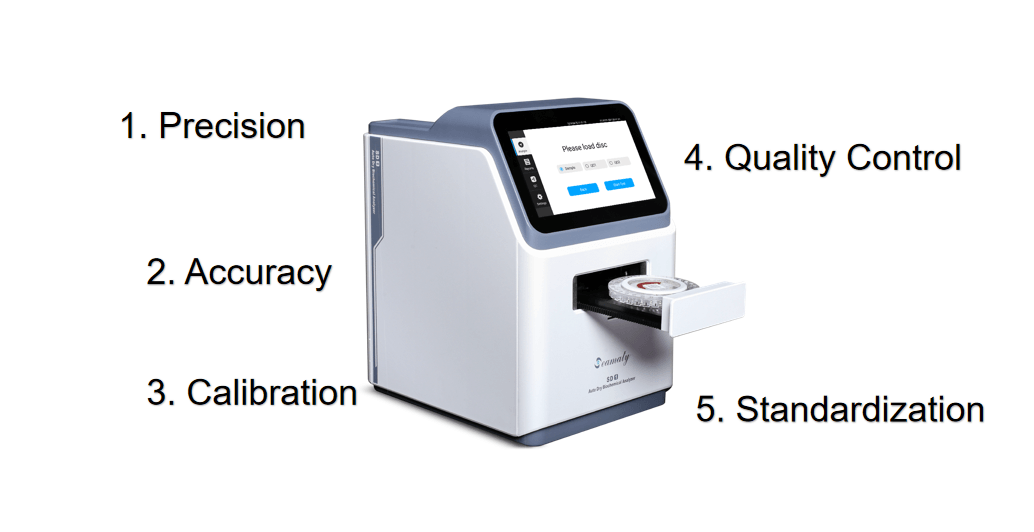In the process of using a fully automatic biochemistry analyzer. We often encounter this situation: when doing a certain item alone, the result is fine. But when it is combined with some items. But the test results appear abnormal.
One of the reasons is the automatic biochemistry analyzer cleaning system with the use of the instrument time accumulation, cleaning effect gradually decline. The degree of reagent cross-contamination increases.
The mutual interference between the reagents of the automatic biochemistry analyzer affects the accuracy and reliability of the test results. This brings a great deviation to the test results. Sometimes it even misleads clinicians and delays the condition of patients, causing serious consequences.
Therefore, to avoid interference between reagents, in the daily biochemical test work is also very important and urgent.
A. The reagent contains the substrate to be measured by the next test. Or contain a reagent component with the next reaction of the substrate has a role. Thus, it directly interferes with the measurement results of the next reaction.
B. Another reason is that the reaction led by the reagent brings indirect interference to the reaction process of the next item. Because in the case of reagent contamination, the next test measured is the result of the combined action of the reactions of the two items before and after.
The possible mutual interference between some known common reagents are as follows.
1) pH change between reagents in the reaction buffer due to the instrument carrying contamination and the pH of the next reaction changes. This will make the next reaction does not achieve the best state.
For example, total serum protein is measured by the bicuculline method. If other conditions are the same, the reaction is at alkaline (pH 8-9) conditions before the protein peptide bonds (-CONH) can all interact with the alkaline copper solution to produce a purple reaction. This enables the total amount of serum protein to be measured completely.
If the pH is <8, the total protein assay is low and directly affects the results of globulin and albumin/globulin. The enzyme activity assay has the fastest response and highest sensitivity at the optimum pH. However, because of the limited buffering capacity, the enzymatic reaction can have invalid values due to carryover contamination.
Most enzyme reactions have a pH between 6.0-7.5. ALP, γ-GT, LDH must be optimal under alkaline conditions.
2) TG, T-CH, UA, MG reagents contain bile acid salts. This can cause serious interference with the circulating enzyme method for the determination of bile acids.
3) ALT (IFCC) and AST (IFCC) reagents contain highly energetic LD components. This has the potential to interfere with the determination of LD.
4) CK (NAC-activated) and CK-MB (NAC-activated) reagents contain Glu components. The principle of their analytical methods contains the process of the already sugar kinase (HK) reaction of Glu. Therefore, it may bring interference to Glu determination, especially to the determination of Glu by HK method may bring serious interference.
5) Magnesium salts are used in the reagents for Glu (HK), CK (NAC-activated), CK-MB (NAC-activated), TG, HDL-C and LDL-C (direct method). The high concentration of Cu2+ in TP reagent may also interfere with Mg2+ determination.
6) ALT, AST, LDH, CK, CK-MB, UA, r-GT, TP, LDH and other reagents due to the presence of K+ in the reagents. It has the same or opposite process with the enzymatic determination of K+. This will interfere with the enzymatic determination of K+.
7) ChE (Butyrylthiocholine), TC (ChOD-PAP), Glu (GOD-PAP), UA (Uricase), α-HBDH (DGKC) and other reagents use phosphate buffer. This will probably interfere with the determination of inorganic phosphorus.
8) Mg2+ reagent (Calmagite) contains EGTA component, which is Ca2+ complexing agent and may bring interference to the determination of Ca2+.
9) CK assay should not be before ALP and Ca assay. Because the addition of EDTA-Na to the CK reaction solution can inhibit ALP activity. This will bind Ca and make the results low.
10) BUN enzyme assay consumes NADH because of glutamate dehydrogenase (GLDH), so it cannot be tested before the substrate NADH (such as ALT, AST).


